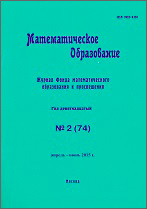|
|
Mathematical Education, 2013, Issue 4(68), Pages 70–85
(Mi mo61)
|
 |
|
 |
Students and teachers of mathematical specialties
What a rigorous proof should be like?
A. Ya. Belova, N. S. Kellinb
a Moscow Institute of Open Education
b Keldysh Applied Mathematics Institute, Academy of Sciences of the USSR
Abstract:
This article deals with mathematical proofs. It's quite evident that humanity knew
about proofs only after the art of writing had appeared. Today one can think about
the following ‘`proportion":
Texts had appeared — then proofs appeared.
Computers appeared — ?
In other words what will happen with the classical proofs which were and are the main
part of math education tomorrow when computers will seriously change our point of
view on computations and etc. We think that it isn’t necessary to use the formal
proofs very often for example only at the beginning of some global investigation.
After that everyone may restrict himself by such reasonings the result of which is to
be clear a) is it possible to conduct the formal proof; b) is it possible to do this
for a reader interested in. This is the main point of the m-comics's idea we suggest.
It is illustrated by two examples: van der Waerden theorem on arithmetic progressions
and Euler theorem on polyhedra. At the end we discuss the math-comics's analogous in
other fields and a short review of math-comics's idea evolution in pedagogy is
represented as well.
Keywords:
formal proof, rigorous proof, m-comics, proof scheme.
Citation:
A. Ya. Belov, N. S. Kellin, “What a rigorous proof should be like?”, Math. Ed., 2013, no. 4(68), 70–85
Linking options:
https://www.mathnet.ru/eng/mo61 https://www.mathnet.ru/eng/mo/y2013/i4/p70
|

|




 Contact us:
Contact us: Terms of Use
Terms of Use
 Registration to the website
Registration to the website Logotypes
Logotypes








 Citation in format
Citation in format 